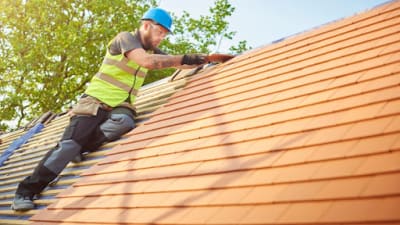Work with an local Toledo Roofer for commercial roofing projects.
Work with an local Toledo Roofer for commercial roofing projects.
Blog Article
How to Assess Different Roof Covering Alternatives for Your Building Requirements
Assessing roof covering options for your structure requires a thorough technique that considers numerous variables such as the planned use the framework, neighborhood environment problems, and product features. It is important to weigh the benefits and disadvantages of different roofing types, from asphalt roof shingles to steel and clay floor tiles, while additionally considering preliminary prices and long-term maintenance. Additionally, understanding energy performance and visual charm can affect your choice. As you ponder these considerations, one inquiry remains: which variables will ultimately lead your choice for a lasting and aesthetically pleasing roof remedy?
Examining Your Building's Needs
To effectively examine roofing alternatives, begin by thoroughly evaluating your structure's needs. Start by thinking about the building's intended usage, as various structures may necessitate varying roof covering requirements. Household roofing systems frequently prioritize appearances and insulation, while industrial buildings may focus on toughness and load-bearing ability.
Next, examine the regional climate conditions that will certainly affect roof covering performance. Factors such as temperature level fluctuations, precipitation levels, and wind patterns can affect product choice and style. A roof that masters a pleasant environment might not execute as well in areas prone to hefty snowfall or extreme warmth.
Furthermore, examine the structural stability of your building. Make certain that the existing framework can support the chosen roof products, specifically if thinking about larger options. It is also important to examine any neighborhood building codes or guidelines that may dictate particular requirements for roof covering systems.

Comparing Roof Covering Products
When an extensive analysis of your building's requirements has been completed, the following step involves comparing numerous roof covering materials. Each product uses distinctive benefits and drawbacks, making it necessary to align your selection with your details demands and circumstances.
Asphalt shingles are widely identified for their price and convenience of installment, making them a preferred alternative for residential buildings. On the various other hand, steel roof, understood for its sturdiness and long life, can endure harsh climate problems however might include a higher preliminary financial investment.
Clay and concrete tiles offer excellent thermal insulation and aesthetic charm, especially for Mediterranean-style design, yet they require an even more durable architectural support because of their weight. Timber drinks deal an all-natural look and excellent insulation buildings yet might require a lot more maintenance and are at risk to fire hazards.
Reviewing Price and Spending Plan
Examining your roof options necessitates a cautious examination of expense and spending plan factors to consider. The total allocate a roofing job makes up several variables, including material prices, labor costs, upkeep, and potential lasting savings. It is vital to develop a clear spending plan prior to checking out specific roof products, as this will certainly direct the decision-making procedure and help you avoid overspending.
Begin by obtaining quotes from several professionals to understand labor expenses in your area. Ensure that these estimates consist learn the facts here now of all required solutions, such as removal of the old roofing system, installation, and any added functions, like insulation or air flow enhancements - Sylvania Roofing Contractor. Next, examine the cost of various roof covering materials, taking into consideration both initial setup costs and expected life-span

Understanding Energy Efficiency
Energy performance plays an essential role in the selection of roof covering materials and systems, dramatically impacting both energy intake and general convenience within a building. A well-chosen roofing can boost thermal efficiency, reducing the need for heating and cooling systems, which in turn reduces power bills and decreases ecological impact.
When evaluating roof covering options, think about materials that show instead of soak up heat. Light or reflective roofing products can considerably decrease roofing system surface temperatures, resulting in lower power usage throughout hot months. Additionally, appropriate insulation and ventilation are necessary to maximize the power performance of the whole roof. Insulation prevents heat transfer, while ventilation reduces warmth accumulation in the attic area.
One more crucial factor is the roof's longevity and maintenance demands. Durable products that need much less frequent substitute add to long-lasting energy financial savings. The energy performance of a roofing system can also be assessed via its conformity with established sustainability ratings such as Power STAR or LEED.
Considering Aesthetic Charm
A roofing system's aesthetic appeal dramatically influences the general look of a building, matching its building style and improving aesthetic charm. Perrysburg Roofer. When evaluating roof options, it is vital to consider just how the picked product, color, and style will integrate with the existing framework and community. A properly designed roofing can boost even the simplest of buildings, transforming them into aesthetic focal factors
Various roof covering materials provide numerous visual top qualities. For example, standard shingles may evoke a traditional beauty, while steel roofing can impart a modern-day, smooth look. Additionally, the color of the roof covering material plays a crucial function; lighter shades can make a building appear more large, while darker tones might develop a cozier atmosphere.
In addition, building aspects, such as dormers and eaves, can boost the roof covering's aesthetic effect. It is recommended to talk to specialist developers or architects to make sure the chosen roofing alternative lines up with the overall layout intent. Inevitably, a roofing system ought to not only provide practical benefits yet additionally contribute favorably to the structure's aesthetic, reflecting the proprietor's preference and the character of the surrounding environment.
Final thought

Report this page